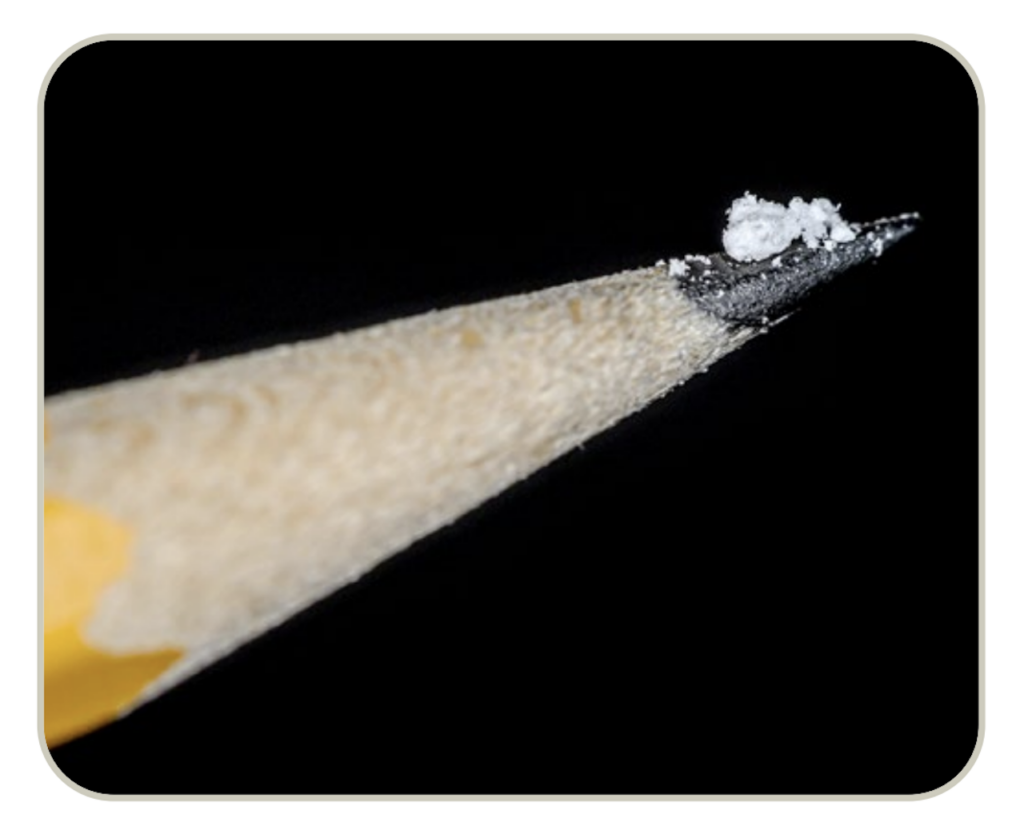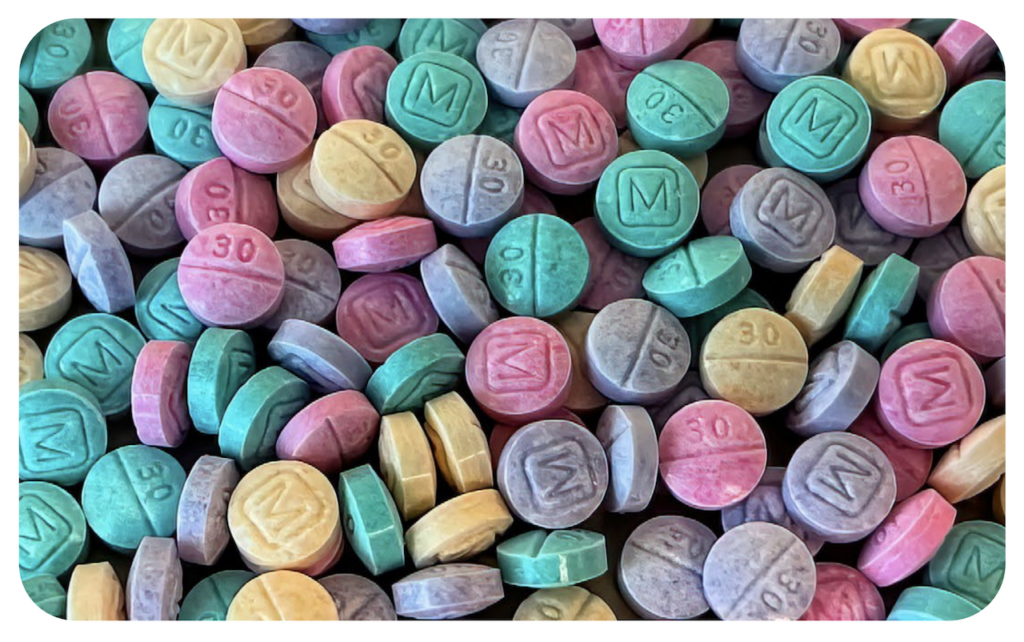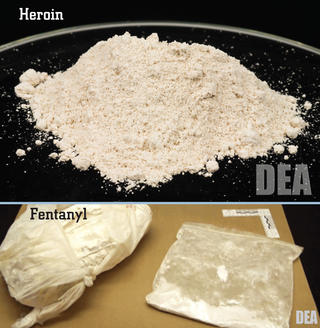Department of Justice/Drug Enforcement Administration
Fentanyl data from the U.S. Drug Enforcement Administration.
Fentanyl
“Fentanyl is a synthetic opioid that is 50-100 times stronger than morphine. Pharmaceutical fentanyl was developed for pain management treatment of cancer patients, applied in a patch on the skin. Because of its powerful opioid properties, Fentanyl is also diverted for abuse. Fentanyl is added to heroin to increase its potency, or be disguised as highly potent heroin. Many users believe that they are purchasing heroin and actually don’t know that they are purchasing fentanyl – which often results in overdose deaths. Clandestinely-produced fentanyl is primarily manufactured in Mexico.”
“Apace, China Girl, China Town, China White, Dance Fever, Goodfellas, Great Bear, He-Man, Poison and Tango & Cash.”
“Intense, short-term high, temporary feelings of euphoria, slowed respiration and reduced blood pressure, nausea, fainting, seizures, death.”
“Similar to other opioid analgesics, fentanyl produces effects such as: relaxation, euphoria, pain relief, sedation, confusion, drowsiness, dizziness, nausea and vomiting, urinary retention, pupillary constriction, and respiratory depression.”
Fentanyl Drug Fact Sheet (U.S. DEA)
WHAT IS FENTANYL?
Fentanyl is a potent synthetic opioid drug approved by the Food and Drug Administration for use as an analgesic (pain relief) and anesthetic. It is approximately 100 times more potent than morphine and 50 times more potent than heroin as an analgesic.
WHAT IS ITS ORIGIN?
Fentanyl was first developed in 1959 and introduced in the 1960s as an intravenous anesthetic. It is legally manufactured and distributed in the United States. Licit fentanyl pharmaceutical products are diverted via theft, fraudulent prescriptions, and illicit distribution by patients, physicians, nurses, physician assistants, nurse practitioners, and pharmacists.
From 2011 through 2021, both fatal overdoses associated with abuse of clandestinely produced fentanyl and fentanyl analogs, and law enforcement encounters increased markedly.
According to the Centers for Disease Control and Prevention (CDC), overdose deaths involving synthetic opioids, excluding methadone were involved in roughly 2,600 drug overdose deaths each year in 2011 and 2012, but from 2013 through 2021, the number of drug overdose deaths involving synthetic opioids, excluding methadone increased dramatically each year, to more than 68,000 in 2021. The total number of overdose deaths for this category was greater than 258,000 for 2013 through 2021. These overdose deaths involving synthetic opioids is primarily driven by illicitly manufactured fentanyl, including fentanyl analogs. Consistent with overdose death data, the trafficking, distribution, and abuse of illicitly produced fentanyl and fentanyl analogs positively correlates with the associated dramatic increase in overdose fatalities.

What are common street names [for fentanyl]?
Common street names include:
• Apache
• China Girl
• China Town
• Dance Fever
• Friend
• Goodfellas
• Great Bear
• He-Man
• Jackpot
• King Ivory
• Murder 8
• Tango & Cash
What does it look like?
Clandestinely produced fentanyl is encountered either as a powder or in fake tablets and is sold alone or in combination with other drugs such as heroin or cocaine.
Fentanyl pharmaceutical products are currently available in the following dosage forms: oral transmucosal lozenges commonly referred to as fentanyl “lollipops” (Actiq®), effervescent buccal tablets (Fentora®), sublingual tablets (Abstral®), sublingual sprays (Subsys®), nasal sprays (Lazanda®), transdermal patches (Duragesic®), and injectable formulations.

How is it abused?
Fentanyl can be injected, snorted/sniffed, smoked, taken orally by pill or tablet, and spiked onto blotter paper. Illicitly produced fentanyl is sold alone or in combination with heroin and other substances and has been identified in fake pills, mimicking pharmaceutical drugs such as oxycodone. Fentanyl patches are abused by removing its gel contents and then injecting or ingesting these contents. Patches have also been frozen, cut into pieces, and placed under the tongue or in the cheek cavity. According to the National Forensic Laboratory Information System – National Estimates Based on All Reports estimates, reports on fentanyl (both pharmaceutical and clandestinely produced) increased from 4,697 in 2014 to over 117,045 in 2020, as reported by federal, state, and local forensic laboratories in the United States.
What is the effect on the body?
Fentanyl, similar to other commonly used opioid analgesics (e.g., morphine), produces effects such as relaxation, euphoria, pain relief, sedation, confusion, drowsiness, dizziness, nausea, vomiting, urinary retention, pupillary constriction, and respiratory depression.
What are the overdose effects?
Overdose may result in stupor, changes in pupillary size, cold and clammy skin, cyanosis, coma, and respiratory failure leading to death. The presence of triad of symptoms such as coma, pinpoint pupils, and respiratory depression are strongly suggestive of opioid poisoning.
Which drugs cause similar effects?
Drugs that cause similar effects include other opioids such as morphine, hydrocodone, oxycodone, hydromorphone, methadone, and heroin.
What is the legal status in the Federal Control Substances Act?
Fentanyl is a Schedule II narcotic under the United States Controlled Substances Act of 1970.



